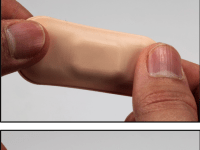

Stroke survivors might suffer from different symptoms such as aphasia that is loss of ability to understand or express speech, and dysphagia that is difficulty or discomfort in swallowing. Proper therapies can alleviate these symptoms. Tracking the patients’ improvement in an accurate and continuous manner would provide important feedback for therapeutic development. Currently, clinicians use voice recorder to measure the patient's speech quality, and large desktop instruments to monitor the patient's swallowing ability.
However, these techniques have multiple limitations. For the voice recorder, the quality and accuracy of the measurement can be easily affected by ambient noise of the measuring environment. Identifying the specific subject’s speech requires expensive labors and computations. The desktop instruments for swallowing measurements are cumbersome and not portable. They also restrain the testing circumstances because large movement of the patient can result in unreliable data collection.
Our device featuring the stretchable sensor offers solution to these problems. First, with its flexible mechanical form factor, the device conformally mounts onto the patient and records clean and accurate data. Taking advantages of the mechanical structural design of 3D buckled serpentine interconnects, the device can stretch 200% without failure
When mounted to the neck, which bridges the circulatory system and respiratory system between head and torso, a single device can acquire heart rate, respiration rate, talking time, and swallowing quality simultaneously. The device is shaped anatomically matching with the suprasternal notch (the notch between the collar bones), so that the patients can place the device on the proper mounting location without a clinician's presence.
The device is mechanically well coupled to the skin, and measures small skin vibration or large core-body movement but not any air-bourne acoustic wave from the ambience. Hence, unlike the microphone which records audible sounds indistinguishably, the device only records the patient's physical activity and is isolated from any disturbance from the environmental noise.
In addition, the device has wireless charging and data transmission functionalities. The electronics are completely encapsulated by the elastomeric membrane to be waterproof. The device utilizes double sided adhesives as an mounting interface between the device and the skin which can be replaced after each use. The device is truly reusable for daily measurements.
With these features and functionalities, the device provides more accurate and unprecedented metrics for the clinicians to understand the stroke survivors’ recovery state and allows them to monitor the patients continuously far beyond the intermittent examinations within clinics.
Video
-
Awards
-
 2018 Medical Honorable Mention
2018 Medical Honorable Mention -
 2018 Top 100 Entries
2018 Top 100 Entries
Like this entry?
-
About the Entrant
- Name:Peter Lee
- Type of entry:teamTeam members:Peter KunHyuck Lee
John A. Rogers
Steve Xu
Xiaoyue Ni - Software used for this entry:Comsol
- Patent status:patented








